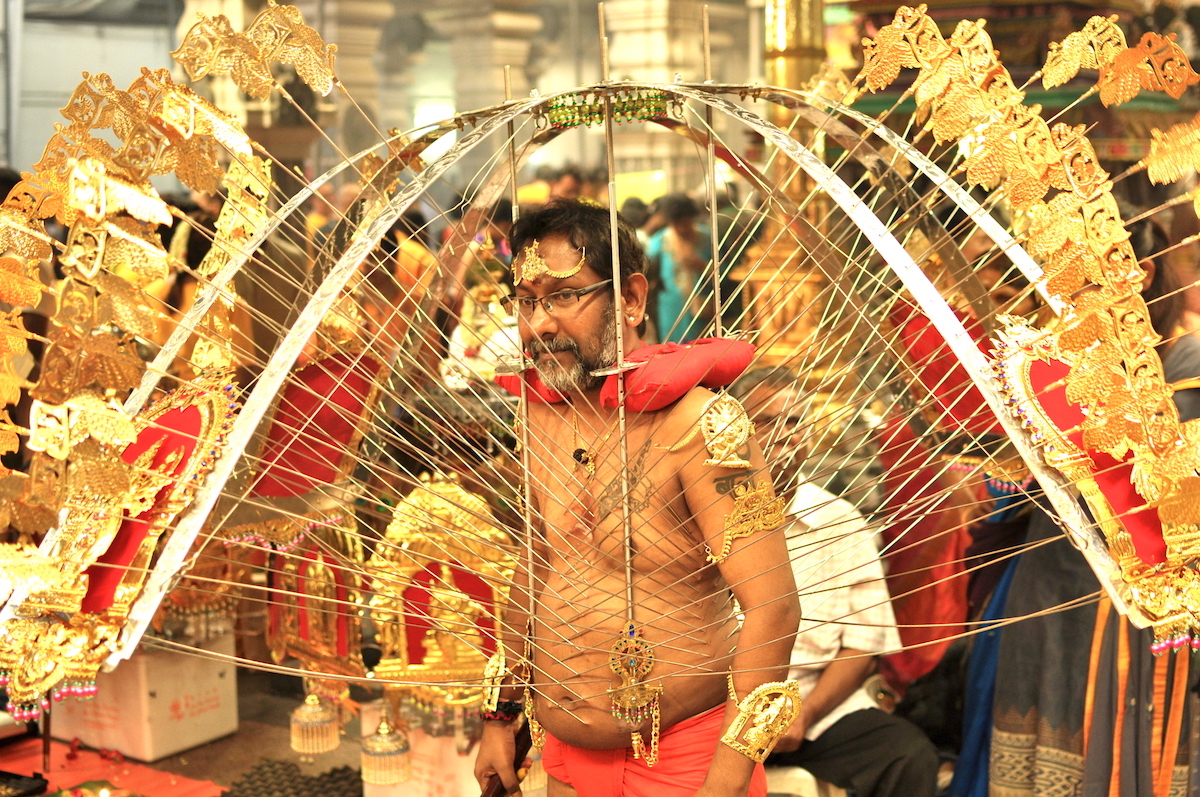A Mini-Guide To Singapore's Thaipusam Festival
A devotee bearing a Kavadi at Sri Srinivasa Perumal (Singapore). Photo: David Mattatia
When you come to Asia from the western world searching for something surprising and different, Thaipusam is one of those “now-we-are-talking” moments you were waiting for.
In a nutshell, Thaipusam is a Hindu festival celebrated among the Tamil community’s in countries such as India, Sri Lanka, Malaysia, Singapore, Indonesia, Thailand or Myanmar and if you are travelling in these areas in January/February, you should definitely check the local cultural agendas to see whether you will be lucky enough to offer your 5 senses an overload of excitement!
In Singapore you can get the exact dates on the Thaipusam official website.
Because we have struggled a bit in our first year of expatriation trying to find bits and pieces of information about this festival, we decided to put together a mini-guide for Singapore's Thaipusam, and hopefully make things easier to newcomers and tourists.
What exactly is Thaipusam?
Thaipusam comes from the junction of two words, the Tamil month called "Thai" (full moon between Jan/Feb) and a star, named "Pusam".
For outsiders, understanding the whole history behind Thaipusam and the meaning of the details of the celebration is an endeavour many will not engage into. So let us put it like this: Thaipusam is about seeking for help from the God Murugan through prayer, spiritual & physical preparation and finally a pilgrimage along a well defined route while carrying and supporting all sorts of burdens, also called kavadis.
Kavadi means "sacrifice at every step" in Tamil.
Devotee bearing kavadi and milk pots at Thaipusam. Photo: Fernanda Brocoletti
Strange as it may seem, the kavadis are usually what the regular turistus fotografus is looking for!
They are amazing proofs of what amount of pain and suffering mankind can endure in the name of faith.
Young man at Serangoon Street during Thaipusam (Singapore). Photo: Patti Neves
While many Murugan devotees will limit themselves to simple and less intrusive kavadis such as the bearing of one or several pots of donation milk, the courageous ones will be performing the entire pilgrimage (in Singapore, route is between 4 and 5 km long) with some form of metal inserted through the body, the most common combination being vertical and horizontal decorated needles preventing devotee from talking and forcing him (or her) to focus on the effort.
Do you know lord Murugan?
Lord Murugan is the Hindu god of war. Son of Parvati and Shiva - and brother of Ganesha, his life story has many versions in Hinduism.
An important deity in the Indian subcontinent since ancient times, Murugan is particularly popular and predominantly worshipped in South India, Sri Lanka, and Malaysia.
In case you are not familiar with Hinduism, the image below illustrates the largest statue of Murugan in the world, located in Batu Caves, in the outskirts of Kuala Lumpur (Malaysia).
Read also: 8 Things Nobody Tells You about Bali
Lord Murugan at Batu Caves, Malaysia. Photo: Patti Neves
At the Malaysian version of Thaipusam, held at the Batu Caves, the devotees climb the stairs and actually enter the cave during the procession.
Probably this route is even more photogenic for the avid spectators (AKA: us) but despite the lack of this amazing setting, the event in Singapore never disappoints.
Thaipusam seemed to us as the most innovative demonstration of painful worshipping we have ever seen in this life.
Devotee bearing hooks and limes (Singapore). Photo: Patti Neves
Which types of kavadis can be seen?
Nail shoes in the best fakir style, fruits hanging on hooks all over the body, hooked milk pots hanging on skin, religious hook-drawn carriages, and body piercings of all styles were seen everywhere.
Not for the faint of heart.
Man bearing a religious hook-drawn carriage. Photo: Fernanda Brocoletti
The impressive and colorful "cage-kavadis" (huge structures decorated with peacock feathers and supported by dozens of needles inserted in thorax and abdomen) are also a common sight.
Some participants look like in a trance, jumping to the music as if nothing was happening. Detail: some of the kavadis can weigh up to 40 kg.
Others walk peacefully, without grimaces, wearing the fashion below.
Thaipusam magic shoes, Singapore. Photo: David Mattatia
HOW IS THE THAIPUSAM CELEBRATION?
Processions are organized among the devotees, who must sign up at the temples and pay the respective fees. They start gathering in the wee hours in Sri Srinivasa Perumal temple followed by the long walk along the streets of Singapore until they reach the final destination (Sri Thendayuthapanie), where they leave the offerings.
External participants are welcome in both temples, and it is common to see family and friends encouraging the procession with songs and drums, as well as many curious foreigners, as the festival is always open to the public.
We feel deep admiration and respect for the devotees, after all, to be a Murugan believer is not an easy task!
Devotee carrying dozens of mangoes hung by hooks. Photo: Patti Neves
While we can only speak for festivities in Singapore, we assume the modus operandi will be more or less similar in other Southeast Asia locations. We hope the basic advice here below will be useful.
Practical tips to attend Thaipusam in Singapore:
Preparation takes place all the night long at the Sri Srinivasa Perumal Temple
This is where all devotees get ready for the pilgrimage and get their kavadis “installed”. You want to be there early as this is probably the most amazing part of your day: incense is burning in each corner, musician’s setup camp all over the temple to accompany the devotees and, of course, you will be able to assist to the largest collective piercing session you have ever seen. We were there just before 6AM but you could go there even before if you can (recommended).
Once you are dizzy from the fume overload, head outside to watch the progressive departure...
...as they leave the temple and hit the road to head west on Serangoon road. Beware, by the time you exit the temple, place will be packed and organization might not let you go back inside anymore. It happened to us. Oh-oh.
Follow the procession at your pace and enjoy the show.
At this point you will have more space to admire the kavadis and to identify the different types and the different patterns.
The walk will take you to Dhoby Gaut metro station and around Fort Canning park...
... finally arriving at the Sri Thendayuthapani Temple on Tank road. The basic laws of pilgrimage traffic science will make this place packed as hell and difficult to enter. So while you will still be able to go around and watch devotees dekavadise, you might not make it in the temple itself to watch the final encounters with God Murugan shrine and the donation acts.
A trick could be to fast forward the whole procession and go straight from departure temple to destination to get there before the bulk of the crowd arrives
Devotees carrying kavadis at Serangoon Road, Singapore. Photo: Fernanda Brocoletti
Still confused? Here's the temples addresses:
Sri Srinivasa Perumal (concentration of devotees, early morning departures):
397 Serangoon Road, 218123 - MRT Farrer Park
and
Sri Thendayuthapanie (arrival temple):
15 Tank Rd, Singapore 238065 - MRT Fort Canning ou MRT Dhoby Ghaut
DRESS CODE
If you are intending to enter the temple, be prepared to dress appropriately - and go barefoot. Go in flip-flops and carry them around in your purse, in a plastic bag.
As the temple may be a bit "dirty" (with leftover milk and offerings on the floor), another good idea is to visit the place in socks, so you don't need to spend half of your time staring at the floor.
Clothing covering the neckline and shoulders, cotton skirts (or pants) are ideal. Forget the shorts and tops, it is the same rule that goes for most of temples in Asia, anyway.
Do you like this post?
Recommend it to your friends via Facebook!
Hover your mouse over the image below to save it on Pinterest!
Read also: 10 Unusual & Cool Things to Do in Ho Chi Minh
I’m constantly blogging about Southeast Asia!
Would like to receive our posts directly on your email?
A few more tips:
If you are looking into a place to stay in Singapore check out this article!
But if you are trying to escape Singapore maybe you should read about Bintan!
Check here another amazing festivals around the world in 2019
Some links in this post are affiliate links.
This means that if you buy anything using our links, I’ll earn a small commission at no extra cost to you!
Your support helps me keep the site going ♡















